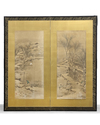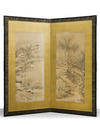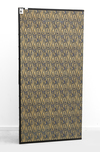Lot 135 A JAPANESE TWO-PANEL SCREEN 19TH CENTURY – LATE EDO TO EARLY MEIJI PERIOD
This elegant two-panel Japanese screen from the 19th century, bridging the late Edo and early Meiji periods, offers a finely detailed depiction of rustic village life set in a tranquil seasonal landscape.
Executed in delicate ink and subtle color on paper, the composition is spread across two vertical panels, each bordered with luxurious gold silk brocade and framed in a traditional black lacquered wood. The left panel portrays a lone farmer drawing water from a well, set against a gentle hillside with sparse vegetation and trees. Further in the background, figures gather—perhaps resting or harvesting—creating a vivid narrative of daily rural life.
The right panel brings us closer to a farmhouse compound, where interactions between villagers are depicted with intimate charm. A woven fence and gate lead to a thatched-roof entrance, as people exchange conversation while a rooster roams freely nearby. Bare winter trees suggest a transition of seasons, rendered with the minimalistic and poetic beauty of Japanese ink painting.
The painting style reflects the influence of Kano school and literati traditions, blending natural observation with idealized storytelling. The use of fine brushwork, atmospheric washes, and restrained color conveys depth, movement, and mood.
180 by 165 cm.



